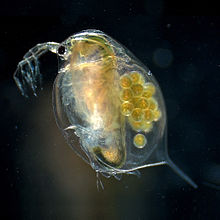| Anomopoda | |
|---|---|

| |
| Daphnia magna (Daphniidae) | |
| Scientific classification | |
| Domain: | Eukaryota |
| Kingdom: | Animalia |
| Phylum: | Arthropoda |
| Class: | Branchiopoda |
| Subclass: | Phyllopoda |
| Superorder: | Diplostraca |
| Order: | Anomopoda G. O. Sars, 1865 |
| Families[1] | |
|
Acantholeberidae Smirnov, 1976 | |
Anomopoda is an order of the superorder Diplostraca. These crustaceans, a type of water flea, are members of the class Branchiopoda.[1] The Anomopoda typically have five pairs of thoracic limbs, but sometimes have six pairs.[2] The head of the Anomopoda lacks a clear separation from the trunk and the posterior, while the abdomen area gradually merges with the anterior of the trunk.[3]
See also
[edit]- Daphnia - water fleas
References
[edit]- ^ a b Alexey Kotov (2010). "Anomopoda". WoRMS. World Register of Marine Species. Retrieved November 23, 2021.
- ^ D. R. Khanna (2004). Biology of Arthropoda. Discovery Publishing House. p. 351. ISBN 81-7141-897-X.
- ^ Henri J. Dumont & Ștefan Negrea (2002). Guides to the Identification of the Microinvertebrates of the Continental Waters of the World. Vol. 19. Backhuys. p. 29. ISBN 978-90-5782-112-7.

Well, that’s interesting to know that Psilotum nudum are known as whisk ferns. Psilotum nudum is the commoner species of the two. While the P. flaccidum is a rare species and is found in the tropical islands. Both the species are usually epiphytic in habit and grow upon tree ferns. These species may also be terrestrial and grow in humus or in the crevices of the rocks.
View the detailed Guide of Psilotum nudum: Detailed Study Of Psilotum Nudum (Whisk Fern), Classification, Anatomy, Reproduction